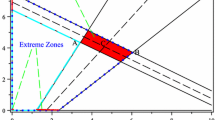Abstract
To the best of our knowledge, only the existing approach (Rabiei et al. in Soft Comput 18(10), 2043–2059, 2014) has been proposed to construct a full interval-valued fuzzy linear regression model [a regression model when the observation of the response, independent variables as well as the regression coefficients are triangular interval-valued fuzzy numbers (TIVFNs)]. However, after a deep study, it is observed that a mathematical incorrect assumption has been considered in this approach. Furthermore, it is observed that to resolve this mathematical incorrect assumption, there is a need to propose the multiplication of an unrestricted TIVFN (regression coefficient) with a restricted TIVFN [observed values of independent variable(s)]. Keeping the same in mind, in this paper, the same type of multiplication is proposed, and with the help of proposed multiplication, a modified approach is proposed to construct a full interval-valued fuzzy regression model. Also, the modified results of some existing real-life problems are obtained with the help of the modified approach.
Similar content being viewed by others
References
Aliev RA, Fazlollahi B, Vahidov R (2002) Genetic algorithms-based fuzzy regression analysis. Soft Comput 6:470–475
Buckley JJ (2005) Fuzzy statistics: regression and prediction. Soft Comput 9:769–775
Celmins A (1987) Least squares model fitting to fuzzy vector data. Fuzzy Sets Syst 22:260–269
Chen FLH, Hsueh CC (2007) A mathematical programming method for formulating a fuzzy regression model based on distance criterion. IEEE Trans Syst Man Cybern B Cybern 37:705–712
Chen LH, Hsueh CC (2009) Fuzzy regression models using the least-squares method based on the concept of distance. IEEE Trans Fuzzy Syst 17(6):1259–1272
Choi SH, Buckley JJ (2008) Fuzzy regression using least absolute deviation estimators. Soft Comput 12:257–263
Hassanpour H, Maleki HR, Yaghoobi MA (2011) A goal programming approach to fuzzy linear regression with fuzzy input–output data. Soft Comput 15:1569–1580
Hong DH, Song LK, Do HY (2001) Fuzzy least-squares linear regression analysis using shape preserving operations. Inf Sci 138:185–193
Kao C, Chyu C (2003) Least squares estimates in fuzzy linear regression analysis. Eur J Oper Res 148:426–435
Kaur J, Kumar A (2013) Mehar’s method for solving fully fuzzy linear programming problems with L–R fuzzy parameters. Appl Math Model 37:7142–7153
Kelkinnama M, Taheri SM (2012) Fuzzy least-absolutes regression using shape preserving operations. Inf Sci 214:105–120
Kim B, Bishu RR (1998) Evaluation of fuzzy linear regression models by comparing membership function. Fuzzy Sets Syst 100:343–352
Li J, Zeng W, Xie J, Yin Q (2016) A new fuzzy regression model based on least absolute deviation. Eng Appl Artif Intell 52:54–64
Mohammadi J, Taheri SM (2004) Pedomodels fitting with fuzzy least squares regression. Iran J Fuzzy Syst 1:45–61
Nasrabadi MM, Nasrabadi E (2004) A mathematical-programming approach to fuzzy linear regression analysis. Appl Math Comput 155:873–881
Papadopoulos BK, Sirpi MA (2003) Similarities and distances in fuzzy regression modeling. Soft Comput 8:556–561
Rabiei MR, Arghami NR, Taheri SM, Gildeh BS (2014) Least-squares approach to regression modeling in full interval-valued fuzzy environment. Soft Comput 18(10):2043–2059
Roldán C, Roldán A, Martínez-Moreno J (2012) A fuzzy regression model based on distances and random variables with crisp input and fuzzy output data: a case study in biomass production. Soft Comput 16:85–795
Taha HA (2003) Operations research: an introduction. Prentice-Hall, Englewood Cliffs
Taheri SM, Kelkinnama M (2012) Fuzzy linear regression based on least absolute deviations. Iran J Fuzzy Syst 9:121–140
Tanaka H, Uejima S, Asai K (1982) Linear regression analysis with fuzzy model. IEEE Trans Syst Man Cybern 12:903–907
Wu HC (2008) Fuzzy linear regression model based on fuzzy scalar product. Soft Comput 12:469–477
Zadeh LA (1965) Fuzzy sets. Inf Control 8:338–353
Zeng W, Feng Q, Li J (2017) Fuzzy least absolute linear regression. Appl Soft Comput 52:1009–1019
Acknowledgements
The authors would like to thank Associate Editor “Professor Mohammad Atif Omar” and the anonymous Reviewers for their constructive suggestions which have led to an improvement in both the quality and clarity of the paper. Furthermore, Dr. Amit Kumar would like to acknowledge the adolescent inner blessings of Mehar (lovely daughter of his cousin sister Dr. Parmpreet Kaur). He believes that MATA VAISHNO DEVI has appeared on earth in the form of Mehar, and without her blessings it would not be possible to think the ideas presented in this paper.
Author information
Authors and Affiliations
Corresponding author
Ethics declarations
Conflict of interest
The authors declare that they have no conflict of interest.
Ethical approval
This article does not contain any studies with human participants or animals performed by any of the authors.
Additional information
Communicated by V. Loia.
Rights and permissions
About this article
Cite this article
Al-Qudaimi, A., Kumar, A. Comment on “Least-squares approach to regression modeling in full interval-valued fuzzy environment”. Soft Comput 23, 10019–10027 (2019). https://doi.org/10.1007/s00500-018-3556-4
Published:
Issue Date:
DOI: https://doi.org/10.1007/s00500-018-3556-4




